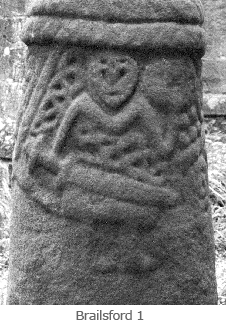 CASSS is delighted to announce the online release of Volume XIII – Derbyshire and Staffordshire – by Jane Hawkes and Philip Sidebottom, originally published in 2018 in the British Academy Series. You can now browse and explore this remarkable collection and access all entries, all photographic images and drawings via our online catalogue.
CASSS is delighted to announce the online release of Volume XIII – Derbyshire and Staffordshire – by Jane Hawkes and Philip Sidebottom, originally published in 2018 in the British Academy Series. You can now browse and explore this remarkable collection and access all entries, all photographic images and drawings via our online catalogue.
With nearly 200 monuments and more than 650 images, this volume covers materials from the counties of Derbyshire and Staffordshire, offering the first comprehensive survey of the Anglo-Saxon and Anglo-Scandinavian sculptures since the 1940s. It provides a new understanding of a highly contested and sought-after region marked by the rise of the Mercian kingdom, the expanding power of Wessex, and the opposing forces of Northumbria. The dynamic exchanges of artistic ideas are illustrated by unique and sometimes haphazard sculptures of the highest quality found throughout the region such as the Lichfield Angel (Lichfield 1) and the Mercian Beasts (Derby 1).
Check out the outstanding chapter dedicated to the monuments of Repton. Martin Biddle offers an in-depth analysis of a near complete sculptural assemblage in its archaeological context, teasing out the relationship between the royal house of Mercia and the Repton monastery, and addresses issues of chronology through careful re-assessment of architectural history, archaeology and iconography (see Repton 1 to 30 in our catalogue).
Explore now the vibrant monuments of the region by following this link.
We are pleased to announce the online release of Volume XII – Nottinghamshire – by Paul Everson and David Stocker, originally published in 2015. You can now explore this impressive collection and access all entries, all photographic images and drawings via our online catalogue
This volume expands the existing inventory of decorative sculpture in the Midlands (following Volume V – Lincolnshire, and Volume X – The Western Midlands), placing Nottinghamshire at the centre of a systematic survey and revealing a particularly rich and complex assemblage. Together with volumes X and XIII, it demonstrates the importance of the region as a long-term place of contested power, whether between the kingdoms of Mercia and Northumbria or within the Danelaw. Volume XII sets the stage for a fundamental re-assessment of sculpture in the region and shows the ways in which local identity can manifest through worked stone, as seen in the figural imagery from Shelford 1.
The strength of this volume resides in the thorough analysis of the landscape context and documentary evidence relating to sculpted monuments. The authors reconsider the sculptural assemblage in its landscape context, teasing out the relationships with significant early church and elite sites such as at South Leverton. This also allows them to highlight how sculpted monuments can be used to define early medieval territories, forming boundary markers (e.g. Stapleford 1) or structure movement across the landscape – for instance by marking river crossings (e.g. Shelford 1).
We are delighted to announce the latest online digital release of the Corpus of Anglo-Saxon Stone Sculpture catalogues. Volume XI - Early Cornish Sculpture by Ann Preston-Jones and Elisabeth Okasha is a special volume in our series. Not only is the first Corpus catalogue to include colour images, the book was also the winner of the prestigious Holyer an Gof Cup in 2015, awarded for the most outstanding publication about Cornwall or in Cornish.
Volume XI surveys the county of Cornwall and provides an analytical catalogue of its early sculpture, highlighting the particular distinctiveness of Cornish sculpture compared to other regions and this catalogue shows off the remarkable range and scale of the Cornish monuments. There is a full photographic record of each monument, taken for the most part by the authors, which highlights the fact that Cornwall, unlike some regions, has many impressive and complete monuments still surviving. A. G. Langdon illustrated a large number of these over a century ago in his seminal Old Cornish Crosses; however, the present volume includes many stones not illustrated by Langdon and offers new interpretations and detailed photographs of others. The monuments with early sculpture include substantial freestanding crosses, altar stones, and some recumbent coped stones. The dating and context of a number of potentially early fonts and some simple cross-incised stones is also discussed. The relationship of the Cornish sculpture to monuments in Wales, Ireland and Western Britain is of particular interest given Cornwall's position as a peninsula jutting into the western seaways. In this context, the authors also consider the potential role of Scandinavian influence.
CASSS is glad to announce the online release of volume X — The Western Midlands — by Richards Bryant, including full catalogue entries, all photographic images and drawing. You can now peruse the inspiring monuments of the region via our online catalogue.
This volume was originally published in 2012 in the British Academy Series. With more than 300 monuments recorded and nearly 800 images, this volume explored the counties of Gloucestershire, Herefordshire, Shropshire and Worcestershire, an area little known for its sculpture material. This enables us to revaluate our understanding of the artistic milieu of the Western Midlands. This volume covers exceptional sculpture centres like Deerhurst and Daglingworth, which are linked with early minsters. However, several 11th century monuments reflect also the rise of the local church and their productions of sculpture such as in Ampney St Mary, Coln Rogers, or Barton-on-the-Heath. The earliest monument can be linked to a British tradition, as in Wroxeter Roman Town 1, Olchon House and St Briavels, whilst a more localised carving culture developed through the extensive carved menagerie of Mercian animals (Acton Beauchamp 1 or Gloucester St Oswald 1) and the fantastic array of figural carvings (Daglingworth 3, Bromyard 1, Deerhurst St Mary 7 and Newent 2). Explore now the remarkable monuments of the region by viewing Volume X of the Corpus of Anglo-Saxon Stone Sculpture.
The monuments pictured are: a crucifixion panel from Daglingworth in Gloucestershire, an animal-head label stop from Deerhurst St Mary in Gloucestershire, and a cross-shaft from Acton Beauchamp in Herefordshire.
 CASSS is pleased to announce the online release of Volume IX — Cheshire and Lancashire — by Richard N. Bailey, originally published in 2010 in the British Academy Series. You can now explore this impressive collection and access the full catalogue entries, all photographic images and drawings via our online catalogue.
CASSS is pleased to announce the online release of Volume IX — Cheshire and Lancashire — by Richard N. Bailey, originally published in 2010 in the British Academy Series. You can now explore this impressive collection and access the full catalogue entries, all photographic images and drawings via our online catalogue.
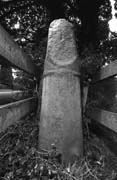 With more than 240 monuments and nearly 750 images across the counties of Cheshire and Lancashire, this volume provides an updated catalogue of all known pre-Norman sculptures of the region. Whilst the early monuments are scarce and most of this collection is of the 10th- and 11th-century period, some early outstanding sites like Sandbach (Market Square) and Lancaster (Priory) illustrate the prolific and sophisticated Christian motifs that developed in the region from the late eighth century onwards.
With more than 240 monuments and nearly 750 images across the counties of Cheshire and Lancashire, this volume provides an updated catalogue of all known pre-Norman sculptures of the region. Whilst the early monuments are scarce and most of this collection is of the 10th- and 11th-century period, some early outstanding sites like Sandbach (Market Square) and Lancaster (Priory) illustrate the prolific and sophisticated Christian motifs that developed in the region from the late eighth century onwards.
With limited documentary evidence, the sculptural dataset is essential to our understanding of the socio-political and religious development of the region. Throughout the catalogue, monuments reflect individually the different influences they received, notably from Northumbria, Mercia and the Irish Sea, while the distribution of specific monuments reflects the development of a localised repertoire (Cheadle, Heysham or Upton). The online release of Volume IX provides a rich and inspirational catalogue for exploration.
CASSS is delighted to announce the online release of Volume VIII — Western Yorkshire — by Elisabeth Coatsworth. You can now browse and explore the substantial collection of monuments of the West Riding of Yorkshire and access the full catalogue entries, all photographic images and drawing via our online catalogue.
This volume was originally published in 2008 in the British Academy Series; with more than 250 monuments recorded and nearly 800 images; it complements the previous publication on the production of Anglo-Saxon stone sculpture in Yorkshire and more generally in the North-Eastern part of England. Encompassing great ecclesiastical estates founded by Wilfrid such as Ripon and major sculptural centres such as Dewsbury and Thornhill, this collection includes a great number of figurative art piece, where inspiration taken from the late antique world and the Carolingian renaissance illustrate a region in contact with the wider European art scene. Explore now the remarkable monuments of the region.
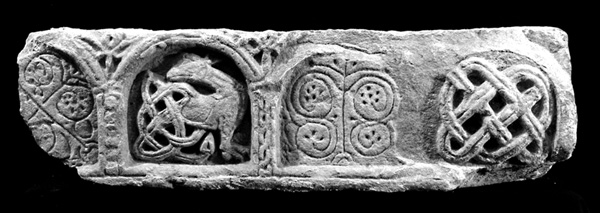
Rothwell 1, Architectural sculpture, part of a string-course or impost
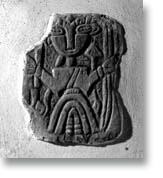 CASSS is delighted to announce the release of all data for volume VII — South West England, by Professor Dame Rosemary Cramp, including full catalogue entries, all photographic images and drawing you can now browse the exceptional array of monuments from the region via our online catalogue.
CASSS is delighted to announce the release of all data for volume VII — South West England, by Professor Dame Rosemary Cramp, including full catalogue entries, all photographic images and drawing you can now browse the exceptional array of monuments from the region via our online catalogue.
 This volume was published in the British Academy Series in 2006 providing a full coverage of the south west of England and comprises the counties of Dorset, Devon, Somerset and Wiltshire. With 240 carved monuments recorded and illustrated by more than 550 plates, this volume explores the range of influences that led to their production and ornament. While the stylistic analysis illustrates the close links of the West Saxons with Mercia and Northumbria for example at the monastic centre of Bath, other sculptures exemplify connections with and influence from Europe. The sculptures of Braunton, Colyton and Dolton and many more, highlight how carvings have been inspired by manuscript models, for example the panel from Glastonbury Abbey that sports zoomorphic motifs paralleled in manuscripts. The online release of Volume VII offers up a rich catalogue for exploration.
This volume was published in the British Academy Series in 2006 providing a full coverage of the south west of England and comprises the counties of Dorset, Devon, Somerset and Wiltshire. With 240 carved monuments recorded and illustrated by more than 550 plates, this volume explores the range of influences that led to their production and ornament. While the stylistic analysis illustrates the close links of the West Saxons with Mercia and Northumbria for example at the monastic centre of Bath, other sculptures exemplify connections with and influence from Europe. The sculptures of Braunton, Colyton and Dolton and many more, highlight how carvings have been inspired by manuscript models, for example the panel from Glastonbury Abbey that sports zoomorphic motifs paralleled in manuscripts. The online release of Volume VII offers up a rich catalogue for exploration.
The pictures displayed are decoration on a shaft from Dolton, Devon (left) and a figure panel from Buckland Newton in Dorset (right). Click on each image to be taken to their relevant listing in Volume VII of the Corpus.
Volume XIII published! We're delighted to announce the publication of Volume XIII —Derbyshire and Staffordshire by Jane Hawkes and Philip Sidebottom. This volume surveys the counties of Derbyshire and Staffordshire and provides an analytical catalogue of the early medieval English stone sculptures of that region. Introductory chapters set the material within historical, topographical, archaeological and art-historical contexts, as well as its scholarly framework, and there are specialist contributions concerning the geology of the monuments and the sculpture from the (originally) royal ecclesiastical site at Repton in Derbyshire. There is a full photographic record of each monument, and many of the images were taken especially for the volume.
The monuments include important collections of material from Derby (St Alkmund's) and Repton, as well as individual sculptures of the highest quality such as the Lichfield Angel, cross-shafts from Bakewell and Bradbourne, the unique column standing at Wolverhampton and the sarcophagus cover from Wirksworth. This volume thus represents a synthesis of resent research and a complete survey of the Anglo-Saxon and Anglo-Scandinavian sculpture of the two counties, and will provide a major contribution to the study of pre-Conquest sculpture in Britain.
Volumes can be purchased direct from the Oxford University Press
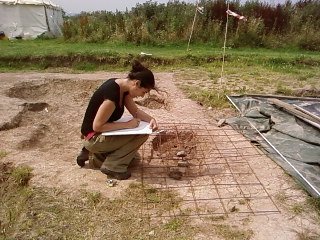 With funding in 2018 from the Arts and Humanities Research Council, the Corpus has entered its final phase with 'Worked in Stone' that will see the entire project brought to completion and released online with the help of the ADS.
With funding in 2018 from the Arts and Humanities Research Council, the Corpus has entered its final phase with 'Worked in Stone' that will see the entire project brought to completion and released online with the help of the ADS.
My name is Celia Orsini and as the part-time post-doctoral researcher for this project, it is my responsibility to facilitate the digital release of the archived photographic images and catalogues collected throughout the project's history. I undertook my research training at Paris 1 Pantheon-Sorbonne, working on funerary archaeology and commemoration in the north-east of England — a PhD project that included looking at commemorative sculpture and its role in the construction of the cultural landscape. You can access some of my publications here. I joined Worked in Stone — the final phase of the Corpus of Anglo-Saxon Stone Sculpture — in 2018 at Durham.
For the past 10 weeks, I have been working on preparing data for the digital release of volume VII. This volume covers the south west of England and comprises the counties of Dorset, Devon, Somerset and Wiltshire. Historically, this region contains part of the Kingdom of Wessex, where a considerable British survival is attested well into the 7th century. Though the Anglo-Saxon settlement has a clear impact on the production of sculpture, it is not surprising to discover widespread reuse of Roman stone as the distribution of Anglo-Saxon sites is patterned around former Roman settlements. The online release of Volume VII and its entire catalogue will allow you to explore the rich sculptural background of this region undergoing deep political and social changes throughout the early medieval period.
We are also collaborating with the Archaeological Data Service on long-term curation and release of the full archive. Some of the ideas we have discussed include much greater searchability of the catalogues and the ability to map material in terms of roads, geology, locale etc. We're hoping to bring to fruition an on-line resource for academics and scholars that can also act as a research aid for local interest groups and students. We'd love to hear from you if you have ideas about how to develop our website and social media presence [celia.orsini at durham.ac.uk].
One of the anticipated outcomes of releasing everything online is to enable researchers to explore these amazing survivals without the restriction of county or even country boundaries. We're especially interested in hearing from other MA and PhD researchers working world-wide on anything related to early medieval sculpture. This three-year project will offer various workshops on Anglo-Saxon stone sculpture and will culminate with a large conference in 2020. By then, we would like to hear from anyone interested in sculpture and conducting new research in this area. If you are completing a masters or PhD thesis that touches on early medieval sculpture we'd like to hear from you — contact me direct at celia.orsini (at) durham.ac.uk.
Avoch Community Archaeology has been undertaking some amazing visualisation work with Scottish early medieval sculptures. As its name implies, Avoch Community Archaeology is a local interest group. Its current focus of investigation is the site of Ormond Castle situated just outside the village of Avoch, on the Black Isle in Scotland, but obtaining the necessary permissions and funding to excavate this Scheduled site is proving difficult for a small village group.
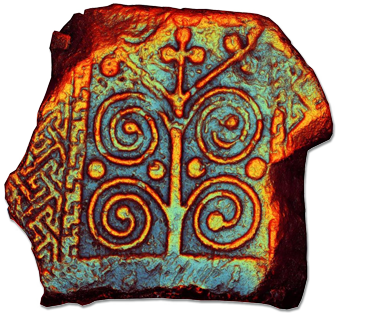 In the meantime, Andy Hickie, one of the group members, has been investigating the site using drone-based photogrammetry and a novel imaging technique called Red Relief Imaging, originally developed by Asia Air Survey Ltd for use with LIDAR data. Andy wondered whether a similar technique could be used to visualize point cloud data derived from aerial photogrammetry and experimented with this, before turning his attention to the Pictish stones held at the Groam House Museum, in Rosemarkie. The images of the Pictish stones are derived from a slightly modified Red Relief Imaging technique.
In the meantime, Andy Hickie, one of the group members, has been investigating the site using drone-based photogrammetry and a novel imaging technique called Red Relief Imaging, originally developed by Asia Air Survey Ltd for use with LIDAR data. Andy wondered whether a similar technique could be used to visualize point cloud data derived from aerial photogrammetry and experimented with this, before turning his attention to the Pictish stones held at the Groam House Museum, in Rosemarkie. The images of the Pictish stones are derived from a slightly modified Red Relief Imaging technique.
Whilst it does not, in this instance, add more to current understanding of the detail and form of the carvings, the addition of a colour dimension does help enable viewers to visualise the complexity and beauty of their decoration. In the case of the Rosemarkie cross slab, the decorative scheme, when viewed using this technique, is highly reminiscent of the artwork seen in Insular illuminated Gospels.
For further information, you can contact Andy Hickie directly at ahick2504@gmail.com or via the Avoch Community Archeology Facebook page.
February is the start of our new project. On the 1st of February we commenced work on Worked in Stone, the new phase of the Corpus. Our team has grown, and this month we have welcomed Dr Celia Orsini a new Post-Doctoral Research Fellow on the project, who will be working largely with the digital corpus. Dr Derek Craig, our long-standing researcher and editor remains with us to the end.
We're delighted to announce that we have full funding from the AHRC to complete the Corpus. Worked in Stone is a new phase of the project that brings together the Durham team (Rosemary Cramp and Sarah Semple) and four new investigators: Jane Hawkes, Helen Gittos, Julian Richards and Jo Story, By 2020 we will have complete and comprehensive coverage in book and digital form.
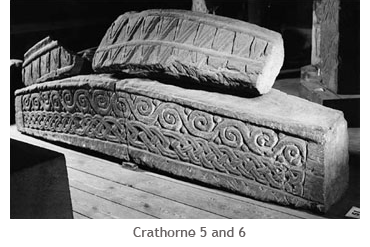 CASSS is delighted to announce the release of all data for Volume VI — Northern Yorkshire, by the late James Lang, including full catalogue entries, all photographic images, drawings and tables and written chapters. You can now browse the remarkable monuments of the region via our online catalogue.
CASSS is delighted to announce the release of all data for Volume VI — Northern Yorkshire, by the late James Lang, including full catalogue entries, all photographic images, drawings and tables and written chapters. You can now browse the remarkable monuments of the region via our online catalogue.
This volume was published in the British Academy Series in 2001 providing insight into the rich and diverse visual heritage of Northern Yorkshire in the pre-Conquest period. Sadly the volume appeared after the death of the author and this major work was finished in part with the help of a research assistant Louise Henderson, sponsored by the Aurelius Trust, the General Editor Rosemary Cramp and Research Fellow Derek Craig. However James Lang's work was left as far as possible untouched, 'so that his inimitable voice comes through' (Introduction — General Editor Rosemary Cramp).
This volume surveys the sculpture in the historic North Riding of Yorkshire (excluding those parts already covered in Volume III). The total of some 400 carvings include important pre-Viking Age monuments, such as the crosses at Croft, Easby and Masham. The excavated sculptures from Whitby Abbey include a range of inscriptions which form crucial epigraphical evidence for our understanding of the pre-Conquest monastery. But Anglo-Scandinavian monuments predominate, with major collections at Brompton, Kirklevington and Lythe. A number of workshops have been identified and it was in this area that the hogback recumbent memorial first appeared.
Much of the Anglian sculpture has stylistic connections with western Yorkshire and Mercia, and the wider connections with Europe are manifest in the iconography and styles of the great crosses at Easby, Masham and Cundall/Aldborough. There are also strong Irish links with the area in the Anglo-Scandinavian period.
This volume marked the culmination of the lifetime's work of a great Anglo-Saxon scholar, but also served to introduce generations of researchers to the remarkable Anglo-Scandinavian monuments of the North Riding, such as the Brompton hogbacks. The catalogue is a crucial piece in the Corpus jigsaw linking Volumes I, II and III, and VIII, and our next imminent volume on Derbyshire and Staffordshire (Vol XIII).
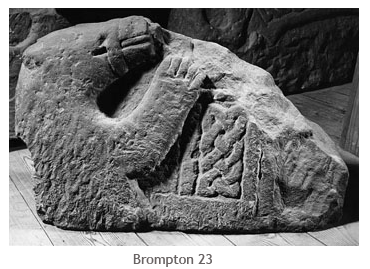 The release of this volume and its associated catalogues brings to an end CASSS's first phase of digital release. The online publication of the chapters, catalogues and images from Volumes I-VI has been achieved with financial support from the Arts and Humanities Research Council (1999-2004), The British Academy (ongoing), The Aurelius Trust (2013-14) and Durham University (2013). Taking original manuscripts and translating them to a form suitable for online release has been no mean feat and is due in large measure to Sarah Price (Soffed Ltd.) our project web-site designer and co-ordinator. Dr Derek Craig took forward the initial preparations and coding of early volumes and has since given generously in terms of detailed oversight of the online material in terms of checking and correcting the catalogues. Funding from The Aurelius Trust supported Dr Celia Orsini in creating high resolution scans of images for Vols IV-VI and transposing and coding the catalogues. The release of Volumes I-VI online means the project has met its long standing commitments to the AHRC. While we hope to continue the on-line release of material, this is dependent on future funding, but we do hope that in the short and long term, we will succeed in freely releasing further volumes for academic and public use.
The release of this volume and its associated catalogues brings to an end CASSS's first phase of digital release. The online publication of the chapters, catalogues and images from Volumes I-VI has been achieved with financial support from the Arts and Humanities Research Council (1999-2004), The British Academy (ongoing), The Aurelius Trust (2013-14) and Durham University (2013). Taking original manuscripts and translating them to a form suitable for online release has been no mean feat and is due in large measure to Sarah Price (Soffed Ltd.) our project web-site designer and co-ordinator. Dr Derek Craig took forward the initial preparations and coding of early volumes and has since given generously in terms of detailed oversight of the online material in terms of checking and correcting the catalogues. Funding from The Aurelius Trust supported Dr Celia Orsini in creating high resolution scans of images for Vols IV-VI and transposing and coding the catalogues. The release of Volumes I-VI online means the project has met its long standing commitments to the AHRC. While we hope to continue the on-line release of material, this is dependent on future funding, but we do hope that in the short and long term, we will succeed in freely releasing further volumes for academic and public use.
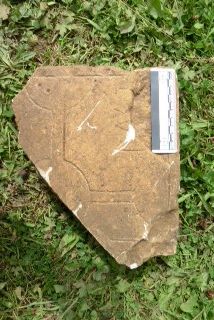 An exciting recent find from Hart on Teeside, has been made by AAG Archaeology. The excavators suggest this name stone fragment shares similarities with other mid-7th to mid-8th century examples from Hartlepool. Although damaged, an inscription can partly be made out - further research is underway. The fragment measures 265mm wide by 213mm long and is 76mm thick.
An exciting recent find from Hart on Teeside, has been made by AAG Archaeology. The excavators suggest this name stone fragment shares similarities with other mid-7th to mid-8th century examples from Hartlepool. Although damaged, an inscription can partly be made out - further research is underway. The fragment measures 265mm wide by 213mm long and is 76mm thick.
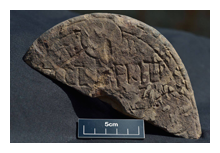 One of the exciting things about the study of early medieval sculpture is that the corpus of known objects continues to expand. Recent excavations led by Durham University and DigVentures on the site of the early medieval monastery at Lindisfarne produced two new stones. We're excited to release an exclusive update from David on the new Lindisfarne sculpture fragments!
One of the exciting things about the study of early medieval sculpture is that the corpus of known objects continues to expand. Recent excavations led by Durham University and DigVentures on the site of the early medieval monastery at Lindisfarne produced two new stones. We're excited to release an exclusive update from David on the new Lindisfarne sculpture fragments!
"The first find was a fragmentary name stone of a type well-known from Holy Island, with fourteen other examples known from the site. It is not terribly elaborate, but does retain the top and right-hand arms of an incised cross with circular terminals, and hints that the central boss of the cross may have been sunken to receive a metal inset. Excitingly, the cross bears a previously unattested Anglo-Saxon name *YTFRI–. No exact parallels are known for this name- although it is possible that it is a version of Eadfrid, which can be found in the Durham Liber Vitae.
The second fragment of sculpture was a cross-incised stone — with an incised image of a shaft (possibly a cross) running down centre of main face defined by parallel incised lines c.20mm apart. This was flanked by two partial Latin crosslet. It is not easy to find parallels to this stone from amongst the existing repertoire of early medieval stone sculpture from Anglo-Saxon England or from Scotland; the difficulty in finding a good parallel is exacerbated by its fragmentary state.
 The best parallels in Scotland are a group of upstanding crosses with subordinate crosses from the Rhinns of Galloway, including examples from Craignarget, Laggangarn, Larg Liddesdale and the Golgotha Stone from Whithorn. This cluster has clear Northumbrian connections, with Whithorn becoming the centre of diocese by the early 8th century AD. From elsewhere in Scotland, a slab from Gleann na Gaoith' (Islay, Argyll) has two crosslets flanking the extended top arm of an outline ring cross, whilst another fragmentary cross, also from Islay, has a ringed cross with flanking crosslets within the ring. Finally, there are parallels with a group of stones from Inishmurray (County Sligo, Ireland), although the Lindisfarne crosslets are not as expanded as these Irish examples. On Inishmurray, the stones are mainly associated with excavated leachta (dry stone built rectangular stone structures, associated with pilgrimage and possibly functioning as altars), and probably date to the 10th or 11th centuries AD, however, the smaller examples, similar in size to the Lindisfarne stone could be earlier.
The best parallels in Scotland are a group of upstanding crosses with subordinate crosses from the Rhinns of Galloway, including examples from Craignarget, Laggangarn, Larg Liddesdale and the Golgotha Stone from Whithorn. This cluster has clear Northumbrian connections, with Whithorn becoming the centre of diocese by the early 8th century AD. From elsewhere in Scotland, a slab from Gleann na Gaoith' (Islay, Argyll) has two crosslets flanking the extended top arm of an outline ring cross, whilst another fragmentary cross, also from Islay, has a ringed cross with flanking crosslets within the ring. Finally, there are parallels with a group of stones from Inishmurray (County Sligo, Ireland), although the Lindisfarne crosslets are not as expanded as these Irish examples. On Inishmurray, the stones are mainly associated with excavated leachta (dry stone built rectangular stone structures, associated with pilgrimage and possibly functioning as altars), and probably date to the 10th or 11th centuries AD, however, the smaller examples, similar in size to the Lindisfarne stone could be earlier.
The excavation team will be returning to Lindisfarne this summer, where they hope to uncover more sculptural material to enhance the existing corpus of Anglo-Saxon sculpture from Northumberland.
Thanks to DigVentures, the Crossman Estate and acknowledgements to Elisabeth Okasha for her reading of the namestone and to Derek Craig for his thoughtful comments on the other fragment."
Across 2016, CASSS together with Professor Joanna Story from Leicester University and Prof Dominic Powlesland at the Landscape Research Centre, Vale of Pickering, Yorkshire, have been experimenting with using Structure from Motion techniques to capture 3-D images of key sculptures. The focus has been on the Soke of Peterborough with some remarkable results - not least the exceptional movable 3-D images of the Hedda Stone. You can see some of the results via Dominic's Sketchfab pages.
We're hoping, funding permitting, to take this work further in future volumes, and to release additional models freely for public use.
Corpus of Anglo-Saxon Stone Sculpture, Volume XIII, Derbyshire and Staffordshire, by Jane Hawkes and Philip Sidebottom, with contributions by Martin Biddle, C. Roger Bristow, Birthe Kjølbye-Biddle, David N. Parsons, Robert Toynton and Barbara Yorke.
This latest volume in the Corpus series will be going to press this autumn, for publication by the British Academy and Oxford University Press before the end of the year.
The Corpus is delighted to announce the forthcoming online release of Volume VI — Northern Yorkshire — by James Lang. This volume surveys the sculpture in the historic North Riding of Yorkshire (excluding those parts already covered in Volume III). The total of some 400 carvings include important pre-Viking Age monuments, such as the crosses at Croft, Easby and Masham. The formatting of data and images is being finalised and Volume VI should be available in June 2017 on this website as a searchable and fully illustrated catalogue.
Durham's very own David Petts has been excavating at Lindisfarne with Dig Ventures Ltd. In the summer of 2016 several important sculpture finds were made. These can be viewed on the project website where you can view the Anglo-Saxon name stone in 3-D.
The Corpus has benefitted across the years from a mosaic of funding. In recent times and in the present, it is generously supported by the Headley Trust, part of the Sainsbury Family Charitable Trusts. With a view maximising the online release, and public awareness and use of the Corpus resources, the project recently submitted a bid to the AHRC for further funding. We remain active in seeking funding to complete this remarkable project, bringing to press and online every fragment of Anglo-Saxon sculpture from across England.
James Lang's M.A. thesis, `Hogbacks in north-eastern England' (1967), although now fifty years old, was a pioneering study of these Viking Age grave-covers in the shape of a house but with bears clasping the ends. Although much work has been done on these since, most authors include a reference to this thesis. It remains one of the primary pieces of research on sculpture and underpins many new avenues of research. http://etheses.dur.ac.uk/12000/
Follow us on Facebook for news updates and discussion on early medieval stone sculpture. We've recently uploaded some colour images from the Early Cornish Sculpture volume XI.
As always, do let us have your views and comments on the usability of this site and our new social media page.
The release of Volumes IV and V means that items of sculpture from a wide geographical area are now available for study. Counties include: Durham and Northumberland, Cumberland, Westmoreland and Lancashire, York and Eastern Yorkshire, South East England and Lincolnshire. The catalogue for volume VI is on its way. We will also make available the chapters from these volumes as an additional free resource. Do contact us and comment on the site and its usability. Queries and questions are always welcome.
We're delighted to announce the publication this year of The Corpus of Anglo-Saxon Stone Sculpture XII, Nottinghamshire, authored by Paul Everson and David Stocker. This new publication provides an authoritative listing, description and illustration of all examples of early medieval decorated stone sculpture in Nottinghamshire. New information revealed by systematic study demonstrates the major contribution that this category of material can make to an obscure and under-investigated period in Midlands history. Nottinghamshire emerges with a distinctive identity in the pre-conquest period, having strong connections both with the Mercian state to its south and with the Northumbrians to the north.
Dr David Petts of Durham University is currently working together with Jane Stockdale and the York Archaeological Trust and Gareth Beale from the York University Centre for Digital Heritage on a community project undertaking Reflectance Transformation Imaging recording the early medieval and medieval sculpture currently housed at the Church of Holy Redeemer in York which was built in the 1960s but incorporates nearly all the Anglo-Scandinavian sculpture from St Mary Bishophill Senior. The end result will be a new element on the church website hosting the RTI images and a viewer, and new display panels in the church.
The York and Eastern Yorkshire catalogue, containing a quantity and range of carvings revealed by excavations at York, has transformed our appreciation of the sculpture from this major medieval centre. The carvings speak of a fusion of cultural impulses over a period when York was the political and economic focus of renewed settlement. The author, the late James Lang, held the post of Inspector of Ancient Monuments, English Heritage.
A new volume of papers dedicated to exploring early medieval stone monuments of the 5th to 11th centuries from a variety of perspectives is due for publication in 2015. Edited by Howard Williams, Jo Kirton and Meggen Gondek, all from the University of Chester, Early Medieval Stone Monuments investigates stone monuments from Ireland, Britain and Scandinavia. Building on recent theoretical trends in archaeology and material culture studies in particular, it uses the themes of materiality, biography and landscape to reveal how carved stones created senses of identity and history for early medieval communities and kingdoms.
Prof Rosemary Cramp and Prof Jo Story, authors of the forthcoming East Midlands Volume, will be presenting on CASSS related research at The British Archaeological Association's 2015 annual conference at Peterborough on the 10th-14th July. The focus of the conference is architecture, art and archaeology throughout the Soke of Peterborough, especially that of Peterborough Cathedral and its precincts from the earliest period through the Middle Ages to the nineteenth century. Click here for more information.
We're delighted to share the news that the project continues to benefit from small grant funding from the British Academy. This funding enables authors to travel and study sculpture in situ. It facilitates the geological analyses and underpins the high quality production of images and maps which complement the scholarly volumes. The funding will also allow us to progress the online release of data, widening access and usage of this unique resource.
Together with Jo Storey from Leicester University, CASSS has won seedcorn funding from both Durham and Leicester Universities to pilot Structure from Motion (SfM) imaging techniques on key pieces of Anglo-Saxon stone sculpture. The recording and modelling is being pioneered by Professor Dominic Powlesland, Field Archaeologist in Residence at Cambridge University. The new 3-D imagery will be made available soon on this site.
We are sad to report that a finely decorated fragment of pre-Conquest sculpture has been reported missing from All Saints Church, Hovingham. This is an important piece from a very significant collection and should be returned to the church. We ask all those following the project to be especially aware in case this item appears for auction or sale. The theft has been reported to the police. If any news of its whereabouts emerges we would ask you to inform them and us as soon as possible.
Volume XI published! We're delighted to announce the publication earlier this year of The Corpus of Anglo-Saxon Stone Sculpture, XI, Early Cornish Sculpture, authored by Ann Preston-Jones and Elisabeth Okasha.
Volume 11 surveys the county of Cornwall and provides an analytical catalogue of its early sculpture, highlighting the particular distinctiveness of Cornish sculpture compared to other regions. Introductory chapters set the material within its topographical, historical and archaeological context, considering it especially in relation to its development as Cornwall, at one time an independent Celtic kingdom, became part of the Anglo-Saxon realm. To fully illuminate the material, the volume includes specialist contributions on the geology of the monuments, the historical background, and the sculpture which continued the tradition of monumental carving in Cornwall after the Norman Conquest. There is a full photographic record of each monument, taken for the most part by the authors, which highlights the fact that Cornwall, unlike some regions, has many impressive and complete monuments still surviving.
Volumes can be purchased direct from the Oxford University Press.
It has been a matter of considerable concern in recent years that several items of Anglo-Saxon sculpture have appeared in the sale-rooms of auction houses, with on occasion items sold to anonymous bidders before any proper publication could be undertaken. It is therefore welcome that an Anglo-Saxon grave-marker, which apparently had been bought with a job lot of stone from Cheshire, was recently saved at auction through purchase by a public spirited private buyer from the UK , and will be published in due course. This is exceptionally good news and we would like to share it.
We are pleased to announce the online publication of the second volume of the Corpus of Anglo-Saxon Stone Sculpture. This latest volume is authored by Professor Richard N. Bailey and Professor Rosemary J. Cramp and covers the pre-1974 counties of Cumberland, Westmoreland and Lancashire-North-of-the-Sands. The resource includes all catalogue entries, with images, and the full text of the 13 specialised chapters that were included in the original printed volume.
We have learned of a welcome extension of the publisher's discount for Volume X: West Midlands. The 40% discount continues to be available until 1st February 2013 from the Oxford University Press. Here is the link to the order form, which you should download, complete and rush to OUP before the deadline expires. Volume X providing even more value, for a limited period.
The release of the new website into the public domain in 2012 represents a significant advance for the project. The development of a searchable on-line catalogue was first achieved by the project as a result of AHRC funding and initially a searchable resource covering all data from Volumes I-III was made available. Loss of AHRC funding brought the development of the site to a halt in 2008. We are delighted to announce, however, the launch of a new website, made possible with funding from the British Academy, which makes available data from volume 1. In due course we hope to release the remaining data from volumes II-X. This is a work in progress and feedback and suggestions are welcome on the design and format of the site. We welcome your comments or suggestions.
Volume X of the Corpus of Anglo-Saxon Stone Scultpure is now available with publisher's discount from the Oxford University Press. This volume surveys the western Midland counties of Gloucestershire, Herefordshire, Shropshire, Warwickshire and Worcestershire. Introductory chapters set the material within an historical, topographical, and art-historical context, and there are specialist contributions concerning the geology of the monuments and the analysis of ninth-century paint. There is a full photographic record of each monument which includes many new illustrations. To receive the discount, which enables a full 40% reduction on the recommended price, please download this order form, complete, and send to the Oxford University Press.
Dr Derek Craig is working with volume author, Richard Bryant, to publish the tenth Corpus volume in 2012. This volume addresses the surviving Anglo-Saxon sculpture of the West Midlands. As well as a full catalogue of all surviving fragments art historical material, this volume includes will include specialist sections on the geology of the monuments and on an analysis of surviving ninth-century paint.
When published (forthcoming), this volume may be purchased from the Oxford University Press.
